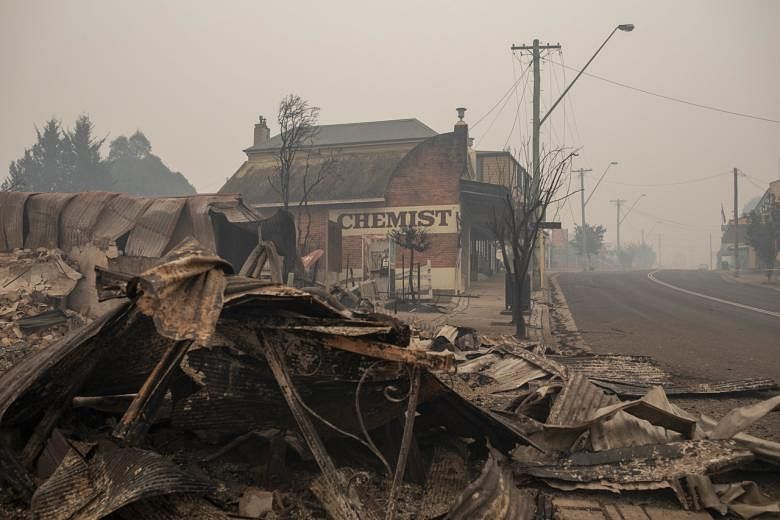SYDNEY (BLOOMBERG) - Australia scrambled its military to help thousands of people stranded in beach-side towns as deadly wildfires continue to sweep through the country's south-east.
Helicopters and navy ships are being sent to the East Gippsland region of Victoria state, where some 4,000 holiday-makers and locals are cut off in the remote township of Mallacoota. Dozens of homes were destroyed when a bush fire tore through the community on Tuesday (Dec 31), forcing people to shelter on the beach or escape by boats.
The terrifying scenes were repeated in coastal towns packed with tourists at the peak of the summer holiday season, as the infernos turned the sky a blood red and rained down embers and ash.
Three people were killed by bush fires across the border in New South Wales state on Tuesday, Rural Fire Service Commissioner Shane Fitzsimmons told reporters, taking the national death toll since the fires broke out several weeks ago to 13.
With other people unaccounted for and more than 150 fires in New South Wales and Victoria continuing to burn, authorities fear that tally will rise as they reach isolated communities left without power and communications.
The crisis has triggered an emotive debate about the impact of global warming in Australia, the world's driest-inhabited continent. It has also fuelled criticism of Prime Minister Scott Morrison's conservative government, which strongly advocates for the nation's massive coal export industry and rejects criticism it is not doing enough to curb emissions.
There appears no end in sight to the bush fire emergency, which is impacting all six states just weeks into a long, hot summer with much of the country gripped by drought. Firefighters were taking advantage of cooler weather on Wednesday to try to contain blazes and reopen roads. But they warned that extreme conditions are expected again by Saturday.
"We have got three months of hot weather to come. We have a dynamic and a dangerous fire situation across the state," Victoria's Emergency Management Commissioner Andrew Crisp told reporters. "We know we have a long way to go with this."
Helicopters will airlift supplies to cut-off communities and deploy fresh firefighting crews, while boats are delivering food and water to some towns. Authorities are considering evacuating Mallacoota residents by boat before Saturday if the road cannot be reopened, Mr Crisp said.
Residents returned to rural villages and townships across the southeast on Wednesday after the fire-front passed through to find scores of homes destroyed. Social media was awash with images of buildings reduced to rubble and burnt cars. Main roads were clogged with traffic as people seized the opportunity to move to safer areas.
The emergency has placed scrutiny on Australia's capacity to combat blazes that have spread over massive areas, pushing fire services largely manned by volunteers to their limits.
Almost 4 million hectares of forest and bushland - an area almost twice the size of Wales - have been destroyed in New South Wales alone.
Fires are so intense they are generating their own weather systems, with dry thunderstorms sparking new blazes. They have already pumped out more than half of the country's annual carbon dioxide emissions, and smoke has drifted some 2,000km to New Zealand, turning the sky orange early Wednesday in the South Island city of Dunedin.
Residents of the Australian capital, Canberra, woke to a new year with air quality more than 15 times the level deemed hazardous as bush fire smoke enveloped the city in a toxic haze.

